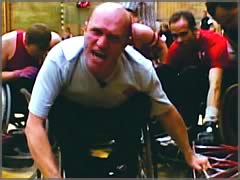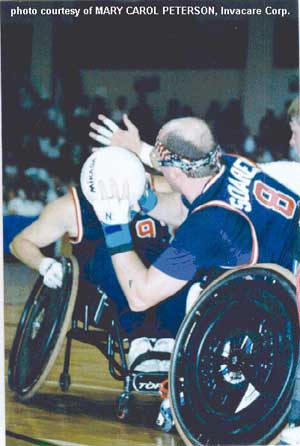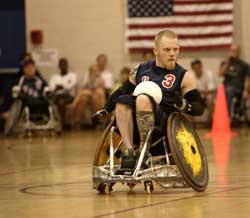 The new documentary Murderball focuses on a sport you may not know a lot about – wheelchair rugby. But this isn’t some heart-tugging, overcoming obstacles movie. Murderball is about a sport just as tough and violent as any "able bodied" (or AB, as the players sometimes call us) sport, with nasty spills and tough hits. The guys who play are as foul mouthed and hard drinking as any athelete who can walk, and they often have girlfriends who are just as hot. And yes, the movie explains, they can have sex with them.
The new documentary Murderball focuses on a sport you may not know a lot about – wheelchair rugby. But this isn’t some heart-tugging, overcoming obstacles movie. Murderball is about a sport just as tough and violent as any "able bodied" (or AB, as the players sometimes call us) sport, with nasty spills and tough hits. The guys who play are as foul mouthed and hard drinking as any athelete who can walk, and they often have girlfriends who are just as hot. And yes, the movie explains, they can have sex with them.
Joe Soares was a wheelchair rugby legend, one of the winningest players in history. But when he didn’t make the USA national team one year he decided to get his revenge by coaching the Canadian team. It creates some great drama for the documentary as he tries to bring his team to their first ever victory over the Americans while the USA team feels betrayed.
Joe has an uncanny resemblence to a younger Robert Duvall – one of the TV guys actually got him to say "I love the smell of napalm in the morning" for his camera. In person he’s much quieter and calmer than the red-faced screaming coach in the film, but a heart attack that he survived halfway through filming may have something to do with that as well.
Murderball opens this Friday.
Q: How were you initially approached about this project? What were you told about it?
Soares: I got approached at the World Championships in Sweden. They walked in and said, “Can we interview you?” I said, “Nope, you should interview my players.” That’s how it started. They interviewed my players and then they got back to me and said I had an interesting story – a USA gold medallist coaching Canada. I was caught right in the middle of that.
We were I think maybe day two when they came in and started filming. That point, if you asked any one of us if the movie would make it to where it is now, we would say you were crazy. It’s something unbelievable in our minds, but you have to give props to [directors] Dana [Shapiro] and Alex [Rubin]. They were relentless.
Q: What were your first thoughts when you saw the movie?
Soares: It was good. They told us it wasn’t totally finished. They flew us in December 8th for a private screening. They’ve added a couple of things since then. It was quite awesome to see not just myself but my entire family on the big screen.
Q: There was some teasing about you going to Canada. Do you think that was fair?
 Soares: Depends who you ask. Personally, I don’t care. I’m a straight shooter. I went to Canada to do a job. I’m sure that teasing wouldn’t be so bad if the US kept whipping everybody. I was a guy that went over there and showed Canada how to defeat the undefeated monster. When you’re on the losing end of that you may not have a very good taste in your mouth. But I had a job to do and I did it, and raised the bar. New Zealand raised it even higher – now everyone knows they have a shot at beating America.
Soares: Depends who you ask. Personally, I don’t care. I’m a straight shooter. I went to Canada to do a job. I’m sure that teasing wouldn’t be so bad if the US kept whipping everybody. I was a guy that went over there and showed Canada how to defeat the undefeated monster. When you’re on the losing end of that you may not have a very good taste in your mouth. But I had a job to do and I did it, and raised the bar. New Zealand raised it even higher – now everyone knows they have a shot at beating America.
Q: In the film your relationship with [Team USA star] Mark Zupan is a little… strained. You guys have some words. What’s your relationship like today?
Soares: We talk. I heard did a deal with Reebok, picked up the phone and gave him a call. We always enjoy when someone with a disability does well. I’m happy for him. I’m in the process of hiring an agent right now and I’m hoping my day will come.
Q: One thing that is really important for people to know is the difference between the Paralympics and the Special Olympics. It’s touched on in the film, but so many people will just not understand. Can you talk about that?
Soares: The Special Olympics happen every year. It’s very admirable what they do. They compete hard, but they’ve got mental disabilities. Although the way some people look at us because of the way we play rugby, they may think we fit in with the mental disabilities! But what we do is quite different, of course. We are confined to wheelchairs but we are not mentally unstable. I don’t know how else to word that. Like Scott says in the movie, we don’t go to the Paralympics for a hug, we go for competition. We train for years. I don’t want to take anything away from the Special Olympics. It’s very admirable what they do, and it means as much to them as this does to us. But many times the able bodied population will confuse us. “I hear you’re going to the Special Olympics.” You have to educate them. But that’s part of what this movie is all about, confronting stereotypes. And that’s one of them.
Q: You guys play really hard. How does your family feel about it? When you first started playing what did your wife have to say?
Soares: My wife came out after watching 11 years of wheelchair basketball and watched us play wheelchair rugby. She said she would never go to another wheelchair basketball game again, she loved the sport. She knows that I have a lot of experience in wheelchair sports. When I started playing wheelchair rugby I had 11 years in wheelchair basketball, and to a certain point a lot of the mechanics are the same. But with wheelchair rugby you can knock the snot out of everybody! That’s part of the game. You have to be, I believe, in a lot better condition. You have to have a lot of endurance. Especially if you’re a 3.5. I was a 3.5 when I played and you have to have a lot of mobility because you’re getting doubled and tripled. The most important thing for the opposing team is to stop number one – number one is a 3.5.
You go down the ladder. If there’s a 3.5 and he’s out there with a 2.5, a 1.5 or a .5 – you cannot exceed 8 points – you better stop that 3.5. Force that ball to number two and stop that 2.5. Force the ball down to the 1.5 – the lower the function the less mobility they have to handle the ball.
Q: Can you touch on what that means, the numbers?
Soares: There are .5 increments, they start at .5 and go to 3.5. They’re different classes. They’re classified according to the function they have. The higher [up the neck] the break, the less function they’ll have on  the court. For instance Christopher Reeve, God bless his soul, he would be a .5. A 3.5 would be closer to a para than a lower level quad. It’s .5 increments based on classifications by doctors who know muscle function. But even that – a player will be classed one class but they’ll show only so much at a bench test, where they’re tested for their classification and then they’ll go out to play and show much more than they showed at the bench test. And the word cheater comes out to play. Because everyone wants to be the lowest amount of points possible, so you can put the most function out there.
the court. For instance Christopher Reeve, God bless his soul, he would be a .5. A 3.5 would be closer to a para than a lower level quad. It’s .5 increments based on classifications by doctors who know muscle function. But even that – a player will be classed one class but they’ll show only so much at a bench test, where they’re tested for their classification and then they’ll go out to play and show much more than they showed at the bench test. And the word cheater comes out to play. Because everyone wants to be the lowest amount of points possible, so you can put the most function out there.
That’s why it’s such a great sport. If you’re a 3.5 the other players can not exceed four and a half. You can have four deuces, you can have any combination adding up to 8 points, but you can’t have more than 8 points. The reason they do that is so no team loads up with four 3.5s and they would slaughter the hell out of everyone. And if that happened the .5s would never play. If there was no classification system the most functional would only play. That wouldn’t be fair.
Q: How many wheelchair rugby teams are there in America?
Soares: It’s got to be around 30. At one point there were 53. We’re down to 30. One of the biggest problems that we have is that there are very rich teams that go around scooping up the best players from around the country.
Q: Is there a lot of money in quad wheelchair?
Soares: No! Absolutely not. Do we look like we have a lot of money?
We’re hoping this movie addresses that. We’re hoping to get a lot more sponsorship when this movie comes out. Believe it or not at the Paralympics, at the World Championships, people just pack it in. There’s an energy that the crowd feeds. It’s a great spectator sport, it really is. I love it when I look in the crowd at a big hit and someone cringes. Of course we’re like “Yeah!”
Q: Are there female players?
Soares: Yes.
Q: On co-ed teams?
Soares: Co-ed teams. There are no female leagues. There are not enough female players to have a female league. In wheelchair basketball there is because there are enough female players to present a league. But in wheelchair rugby there’s a girl here or a girl there.
One of my players last year wouldn’t hit a girl. We were going to win anyway, but I asked him, “Why didn’t you smack here?” He said, “Aw boss, she smelled so good and looked so cute!”
Q: Who is drawn to wheelchair rugby? What’s the personality type?
Soares: If you played football before. If you played active sports. If you want to rehab your body and your mind now and you want to have a chance to play for a national team. Or just to be the best you can be. That type of person. A person who is motivated, who isn’t faint of heart, who loves a challenge. When you’re out there it’s you or the other guy. It’s like a boxer. I don’t want to hurt anybody, but if it’s me or you…
Q: Is it a tough sell to new recruits?
Soares: Some see it and they fall in love. Like, “Yes that’s me, and I can’t wait to get out there.” In the movie you saw Keith, once he got in the chair he didn’t want to get out. Others see it and think, “This is not for me!”
If you were an active athlete growing up and tried different sports growing up, you will give this a shot. Let’s face it, we were the guinea pigs. We were the ones that used to get broken legs and broken feet, because our legs used to stick out. Now there are rules and regulations so that the legs have to be tucked in. There are custom chairs now, back then we played in our every day chairs. We would destroy our everyday chairs and we would be like, “Now what do we do? We still have to get around!” Over time we had our everyday chair and our sports chair. You absolutely have to have that. You can’t mix both.
When we go to tournaments, if you have a team going, you’ll have 12 sports chairs and 12 everyday chairs. Occasionally because of lack of rooms for baggage and all that, you may not have your bags for a day or two. Or you may not have your rugby chair. Or you’ll have your rugby chair but it’ll look like it got trashed. The airlines do do a job on us sometimes.
Q: Who designed the rugby chair?
 Soares: It was a lot of times ma and pa shops. We also had rules and regulations that this would be so wide and the length would be that. There has been a war going on between the high pointers and the low pointers. The low pointers want these little hook jobs, they want to have like what we call a cowcatcher. They just want to swallow your wheel up. They’re not as fast as we are so if they catch you they want to grab you like Dr. Claw. Where we come up with the wings. And everything they come up with we have to offset.
Soares: It was a lot of times ma and pa shops. We also had rules and regulations that this would be so wide and the length would be that. There has been a war going on between the high pointers and the low pointers. The low pointers want these little hook jobs, they want to have like what we call a cowcatcher. They just want to swallow your wheel up. They’re not as fast as we are so if they catch you they want to grab you like Dr. Claw. Where we come up with the wings. And everything they come up with we have to offset.
And it becomes very expensive after a while. All of that welding – not only are you spending all that money designing everything but the more you weld the weaker the aluminum gets.
Q: Is there a standard version now, or is everyone’s unique?
Soares: There’s a standard, but everyone’s is a little unique. Some people like this much bumper – when you have a disability, everything starts with balance. If you’ve ever played sports as an able body, the coach tells you everything starts with balance. Same thing with wheelchair sports. You can’t push your chair really fast if you’re flopping all over the place. That aspect is different. I have been a big promoter of having one standard offensive chair and one standard defensive chair. It would bring out the skill a lot more in the player. Some players are real good because they’ve got a chair that does a lot of the work for them. Some players are good but they’ve got bad equipment. It’s a sport where you do need to keep up with the Joneses. You’re only as good as your equipment.
Q: Is it tough getting sponsored, in general?
Soames: The top players get sponsored but the average player, no way.
Q: You talk about the rules and regulations but you’re out there without pads or helmets – I assume that a lot of the players are in wheelchairs because of injuries and might be more sensitive to further damage. How can you play without protection?
Soares: What are we going to break our necks? Oh, we did that already!
You learn not to lean with your head. You learn also that there’s a certain amount of respect out there. Hitting from behind is illegal. Very few times do you have a guy coming in full blast from behind and trying to hurt someone. There’s ethics. Of course you’re going to have a swelled up knee, but if you put a pad on that knee, it’ll still get swelled up. I’ve seen people play with elbow pads. If you wear a helmet, you’re not going to be as pretty as possible! All kidding aside, some players wear helmets.
I’ll tell you, the players that wear helmets are the ones that went down hard, slammed their heads and got concussions. I only know of two players in the whole league who wear helmets. If you’ll recall in the NHL hockey goalies never wore a mask. The first guy to wear a mask was a big time wuss. And helmets – hockey players never wore helmets. First guy to wear a helmet – big, big wuss! But as the years went along it became mandatory. Our big thing was anti-tip wheelie bars. Nobody wanted a wheelie bar. You should be macho, you should be able to flip over backwards! But it’s when you flip over backwards that you get really hurt. So now it’s mandatory that you not only have one wheelie bar, but two wheelie bars. They cannot be more then 3/8 of an inch off the ground.